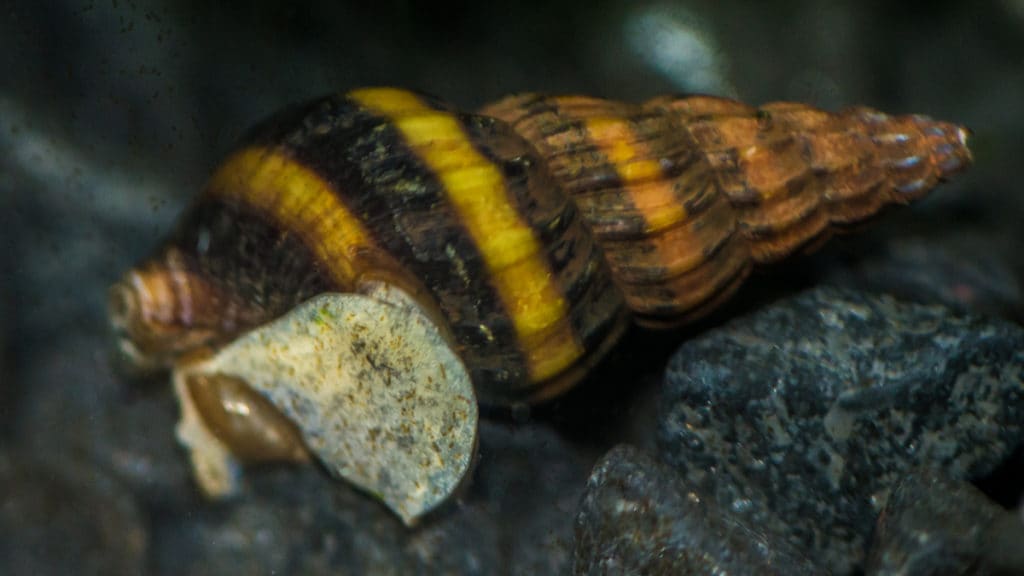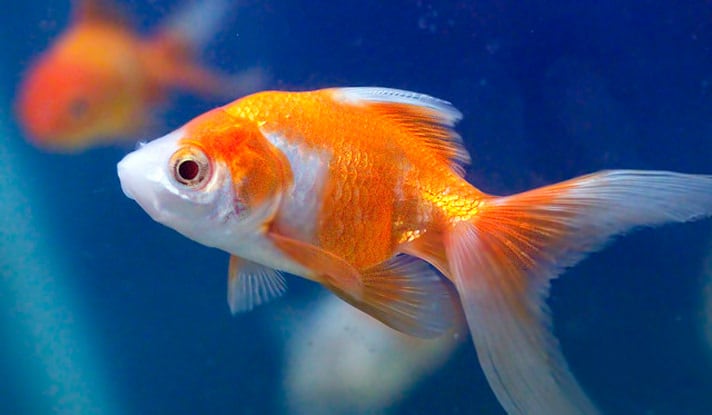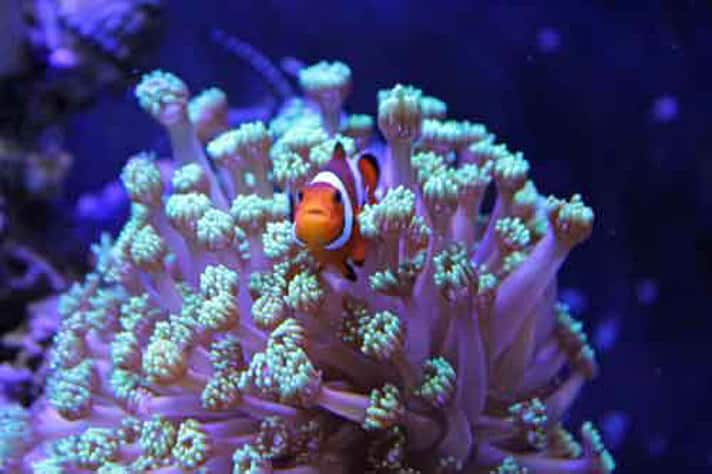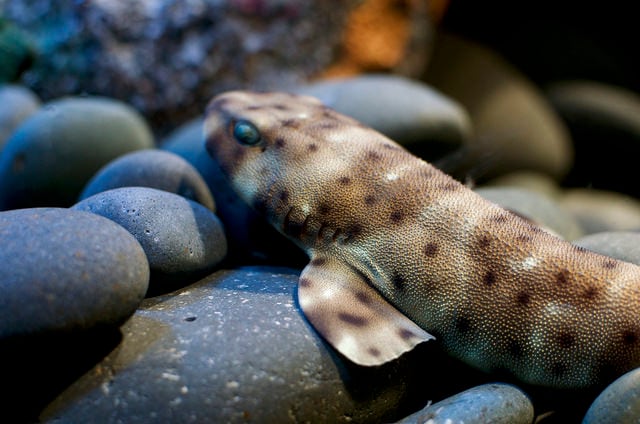Melanoides tuberculata snails, often called trumpet snails, are prized in many planted tanks for the same reason that earthworms are welcome in gardens: their movement through the substrate is beneficial to the plants. Yet it only takes one tiny, hard-shelled trumpet snail to wreak havoc on the impeller blades of a power filter. Similarly, ramshorn snails (Planorbis spp.) are often put into rearing tanks with free-swimming fry to help take care of uneaten food, which they do enthusiastically. The downside is that if they get plenty of food, they can breed explosively, overwhelming a tank in a surprisingly short time.
In short, despite the undeniable benefits of snails, they simply are not welcome in some situations and/or setups, at least not in large numbers. True, if you avoid overfeeding, you can help curb their reproduction and keep their numbers under control. However, this can be an issue in tanks where plenty of snail food needs to be available at all times. I was amazed at the fecundity of ramshorn snails sharing an aquarium with a batch of Ancistrus fry I was growing out. The near-constant presence of soft vegetable matter fueled a population explosion.
Once we have decided that our snails are too numerous, what is the best way to remove them? Manual removal and trapping can reduce their numbers. Some fish snack on them, and others are very effective snail hunters, such as most pufferfish and many loaches. As a last resort, there are commercially available chemicals sold for use in aquaria that can kill snails, if used as directed. All of these methods can play a role in snail control, but a few years ago, a new biological weapon appeared in the aquarists’ potential anti-snail arsenal: the assassin snail. The name says it all—this species actually attacks and eats other aquarium snails.
Assassin snails (Clea helena) are distinctive in appearance, and thus easy to recognize. They sport an attractive black- and light brown-striped shell, a light-colored body with small, darker flecks, and a very thin, prominent proboscis, something like the proboscis of a trumpet snail but much thinner and lighter in color. A few years ago, I bought five of these snails, and I have been very pleased with the results. This article documents my experience with these shelled assassins.
Meeting Clea helena
I have always been intrigued by biological controls, so it didn’t take much to interest me in the assassin snail. It must have been about six years ago when I first became aware of this species via an advertisement on an online auction site, posted by a seller from somewhere in Europe. The price at the time was prohibitive, but I was intrigued. I began to do a little more research, so by the time I saw them for the first time at my local fish store in September of 2009, I felt I was ready to try them out.
A short time and about $15 later, I placed five individuals in a 10-gallon tank, which they shared for a time with some red cherry shrimp, a young bristlenose pleco, and some ramshorn and pond snails. There were not many snails in the fish aquarium to start with, so I bolstered the food supply by seeding the tank with ramshorns and pond snails from a snail breeding tank that I maintained for my dwarf puffers.
Within an hour, I saw at least one assassin snail attacking a large ramshorn. Though it apparently abandoned the attack, within a few days I noticed that the population of ramshorn and pond snails had dwindled somewhat, so I added more as needed every few days.
Feeding Assassin Snails
As previously mentioned, I used to maintain a snail-breeding tank as a food source for a dwarf pufferfish or two. Once I began to use these ramshorns and pond snails to feed my assassin snails, demand soon exceeded my supply. I moved the assassins into a 55-gallon tank, complete with a large number of Malaysian trumpet snails inhabiting the gravel. Within a month or so, all that remained were empty shells.
Some weeks later, because my population of ramshorns and pond snails needed a bit of recovery time, I asked a local fish store if they would mind parting with a few of their abundant trumpet snails as fodder for my assassin snails. Wishing to be rid of them, the manager enthusiastically bagged me a few dozen. I added them to my tank, and within a couple of weeks the majority of the trumpet snails had been dispatched by their carnivorous cousins. For a while I would see the odd live trumpet snail, but much more common were empty shells on top of the substrate. When my supply of feeder snails abated, the fish store was happy to give me more as often as I wanted them.
It was interesting to see that the assassins seemed to sense when food was added, even at some distance away. This was apparent as these predatory mollusks often burrowed into the substrate and stayed quite still, until they sensed prey. Within minutes they emerged, and began crawling actively about the tank, proboscis fully extended. Once the food source was located, they even attacked in groups.
In the years since I purchased my first assassin snails, I’ve learned that, while they take some time, these predaceous gastropods will eventually eliminate several types of snails in an aquarium. I have given them ramshorn, pond and Malaysian trumpet snails. The only species that I have that they don’t seem to eliminate is the tiny, limpet-like cap snail, which is so diminutive that it’s never been a problem.
I have not tried other species, but some people report that assassins prey on olive nerites, while others say that they leave them alone. Even larger snails, such as mystery snails, are apparently not immune if the assassins get hungry enough. Some snails sport a protective door, or operculum, that closes the shell opening tightly when the snail is threatened. It is possible that some species with operculae can withstand an onslaught from an assassin snail, although trumpet snails have this structure, and it does nothing to deter the assassins.
No Snails Left? No Problem
But what happens when the assassin snail has eaten all of the other snails in a tank? Luckily, it is able to subsist on other food. It will take fish food like flakes, pellets and algae chips, as well as graze on algae and biofilm. It is believed, however, that an assassin snail’s reproductive rate is slowed or halted unless its fare is protein-rich. According to some sources at least, in the absence of snails, fare such as bloodworms will allow assassin snails to continue to breed, but fish flakes and whatever it can scavenge may not.
When I cannot offer snails, I feed high-protein pellets along with supplemental frozen, meaty food (usually cubes of frozen mussels) in an “assassin feeder.” This consists of a plastic water bottle with a few small holes cut into the sides, strung onto a loop of fishing line. The small holes limit the competition from the fish that share the tank. I lower this feeder down to the substrate, the snails feed, and then I haul the bottle back up.
As an informal experiment, I put just one adult assassin snail into a 20-gallon high tank that had some ramshorns and pond snails in it. After about three months, all gastropods besides the assassin were gone. It seems that large numbers of assassin snails are not necessary to help control snails, although I am not certain how one assassin would fare against hundreds of other snails.
One source mentioned that assassin snails ate hydra. Others report that C. helena does not affect hydra populations. I can only report my experience. I have long fed microworms to the guppies in the tank where the assassins breed and, before adding the snails, I did have an opportunistic and persistent population of hydra on the glass, thriving on the microworms. While I cannot attribute the disappearance of the hydra to the assassin snails with 100 percent certainty, I see few, if any, hydra in tanks with assassins in them, even in tanks regularly fed microworms.
Breeding Assassin Snails
Some snails are hermaphrodites, containing male and female reproductive organs. When such snails mate, each snail is capable of producing eggs or young. It is reported that each assassin snail, however, is born a male or a female and stays that way. Consequently, if you would like to breed assassin snails, purchase at least five or six in hopes of obtaining individuals of both sexes, as I did. Feed the snails well on meaty foods, especially snails. As previously mentioned, the snails seem to depend on a meaty diet for good reproduction.
A week to 10 days after purchasing five assassin snails, I noticed the first egg. Unlike many familiar aquarium snails, the assassin snail lays eggs individually, in small, translucent, vaguely shield-shaped pouches. Both the pouch and the round center of the egg are light in color.
Though the snails began to produce dozens of eggs, it was some time before I saw any juveniles in my tank. Even now, the assassin population has never reached the density that many other snails will. This, of course, is a good thing. Much of the appeal of the assassin snail is the fact that it is less prolific than many familiar aquarium snails. There would be little point in reducing the population of one species, only to be overrun by another.
It was about five months from when I brought the assassins home before I sighted a juvenile. At the time, it was about a 1/4 inch long, so it had obviously hatched quite some time before that. Part of the reason for such a long interval between my purchase and first sighting was the thick growth of dwarf sag (Sagittaria subulata) that carpeted the tank. Shortly after that first glimpse, I began to spot a number of juvenile assassins. Though these snails do not breed at anything resembling the rate of many of their familiar cousins, after a year or two I began to produce enough of a surplus in my 55-gallon tank that I can supply a local fish store with a number of these snails from time to time.
Care Guidelines For The Assassin Snail
This species hails from Southeast Asia, so tropical temperatures in the mid 70 to mid 80 degrees Fahrenheit probably suit it best. Most snails, due to their need for minerals to keep the shell in good condition, tend to favor water that is on the hard and alkaline side, so it is logical to assume that this holds true for the assassin snail. It does well for me in moderately hard water.
Assassin snails appear to utilize fine-grained substrate for digging, though most of mine are in a tank with larger gravel particles, in which they are breeding without problems. Any lighting intensity and schedule that you and your plants and fish are happy with will probably suit C. helena fine. Mine seem to prosper in high-, medium- and low-light aquaria.
Assassin Snail Tankmates
I expect that any fish species that enjoys snails in its diet would appreciate assassin snails as much as any other species. Puffers and most medium to large loaches are probably poor choices as tankmates. Any fish that will generally leave snails alone should be compatible.
I have kept assassin snails with a variety of fish without any trouble, as well as with red cherry shrimp. Assassin snails do not appear to cannibalize members of their own species, at least not in my experience. There are reports in online forums of this snail attacking and eating species other than snails, such as red cherry shrimp and small fish. I can neither confirm nor deny such reports, though I have never had any trouble of that sort.
Whether you want to eliminate pest snails, or your interest is piqued by this carnivorous mollusk, assassin snails can be a fascinating invertebrate to add to your tank.
Rus Wilson has kept and bred a variety of aquatic creatures over the past 30 years. He and his wife, Kelly, host a weekly aquarium podcast available at aquarimax.com.
Featured Image: via Ian Grainger
Share:









